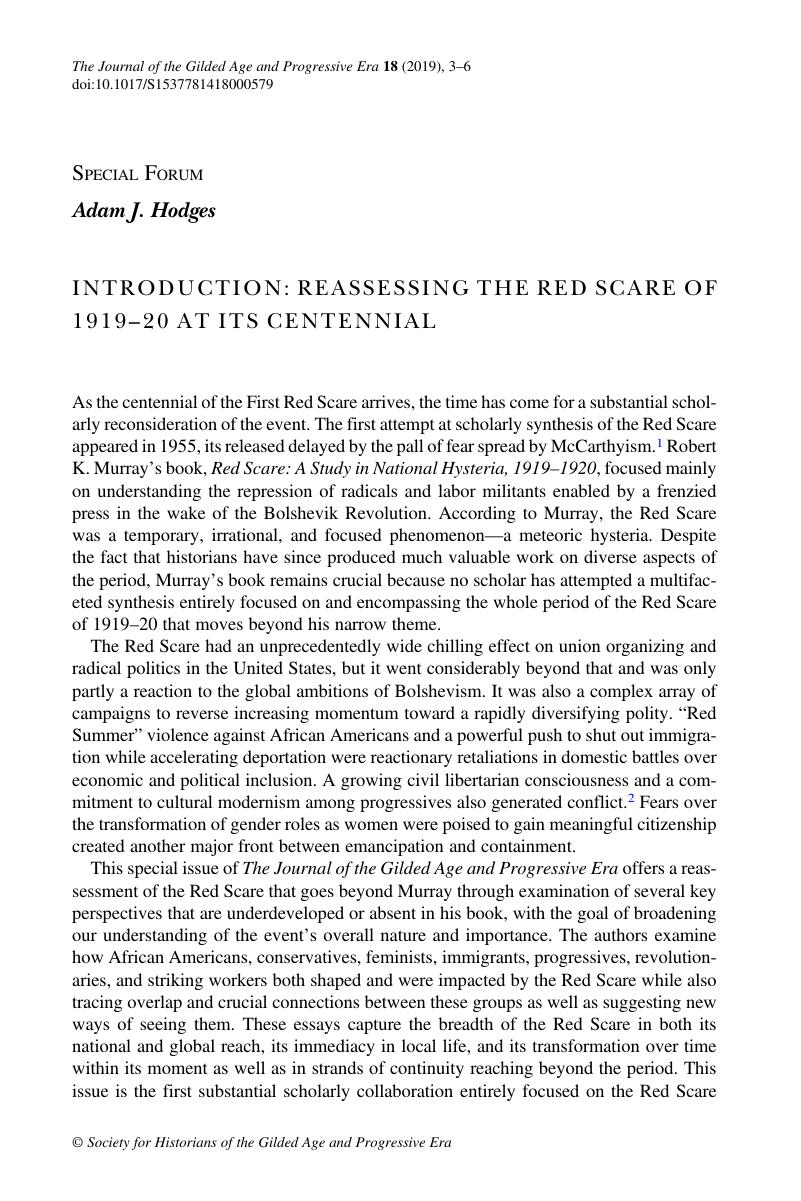Article contents
INTRODUCTION: REASSESSING THE RED SCARE OF 1919–20 AT ITS CENTENNIAL
Published online by Cambridge University Press: 22 January 2019
Abstract

- Type
- Special Forum
- Information
- Copyright
- Copyright © Society for Historians of the Gilded Age and Progressive Era 2019
References
NOTES
1 Murray recounted this extraordinary and sorry tale in an interview, many years later: Lee W. Formwalt, “Robert Murray's Two Red Scares,” OAH Newsletter (Nov. 2003): 4. He hints at the impact of the current climate in the Sept. 1954 preface to his book: Murray, Robert K., Red Scare: A Study in National Hysteria, 1919–1920 (Minneapolis: University of Minnesota Press, 1955)Google Scholar.
2 On the development and varied forms of cultural modernism beyond literature, and its societal impact, see Wilk, Christopher, ed., Modernism: Designing a New World (London: Victoria & Albert Museum, 2006)Google Scholar.
3 The first three chapters of Murray's Red Scare establish a sophisticated context for the rest of the book to build upon. It then proceeds roughly chronologically through 1919–20 over the next twelve chapters before concluding. The Seattle general strike is the focus of Chapter Four and marks the onset of his ordered examination of the period.
4 On repression and political culture during the war, a good starting point is Capozzola, Christopher, Uncle Sam Wants You: World War I and the Making of the Modern American Citizen (New York: Oxford University Press, 2008)CrossRefGoogle Scholar.
5 New York Times, Feb. 6, 1919, 1.
6 On the U.S. military campaign in Russia, see Foglesong, David S., America's Secret War Against Bolshevism: U.S. Intervention in the Russian Civil War, 1917–1920 (Chapel Hill: University of North Carolina Press, 1995)Google Scholar.
7 On the Meuse-Argonne Offensive, see Ferrell, Robert H., America's Deadliest Battle: Meuse-Argonne, 1918 (Lawrence: University Press of Kansas, 2007)Google Scholar.
8 Murray, Red Scare, 14, makes brief mention of the persistence of strong anti-German feeling. Quote on p. 15.
9 Murray, Red Scare, 58.
10 For Murray's take on the Wall Street bombing and the fall 1920 presidential campaign, see Murray, Red Scare, 257–62. For a full account of the Wall Street bombing saga, see Gage, Beverly, The Day Wall Street Exploded: A Story of America in Its First Age of Terror (New York: Oxford University Press, 2009)Google Scholar. The Oklahoma City reference is on p. 1.
11 Weinrib, Laura, “Against Intolerance: The Red Scare Roots of Legal Liberalism,” The Journal of the Gilded Age and Progressive Era 18 (Jan. 2019): 7Google Scholar.
12 Pope-Obeda, Emily, “Expelling the Foreign-Born Menace: Immigration Dissent, the Early Deportation State, and the First American Red Scare,” The Journal of the Gilded Age and Progressive Era 18 (Jan. 2019): 34–35Google Scholar.
13 Mickenberg, Julia L., “New Women in Red: Revolutionary Russia, Feminism, and the First Red Scare,” The Journal of the Gilded Age and Progressive Era 18 (Jan. 2019): 58–59Google Scholar.
14 Hodges, Adam J., “Understanding a National and Global Red Scare/Red Summer Through the Local Invention of Solidarities,” The Journal of the Gilded Age and Progressive Era 18 (Jan. 2019): 83Google Scholar.
- 3
- Cited by




